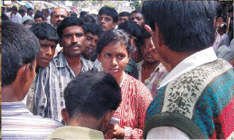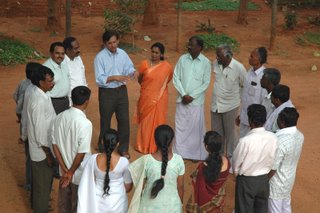Land Equation: Breaking the Cycle of Poverty
Of the 6 billion people presently living on our plant, over 60 percent or 3.5 to 4 billion are in rural areas. In India alone, nearly 700 million people live in the villages. The rural population is increasing at a faster pace than their urban counterpart, mostly as a result of illiteracy, lack of access to birth control measures, and poverty. The pace of overall development in most countries does not k eep up with the needs of this increasing population. The result is that there are more poor people in the world today than 50 years ago, and most live in rural areas.
eep up with the needs of this increasing population. The result is that there are more poor people in the world today than 50 years ago, and most live in rural areas.
According to the U.N. and the World Bank, nearly 35 percent of the world population subsists on less than $1 in daily income. Over 50 percent live under $2 per day. Depending on which of these two yardsticks is used for measuring poverty, there are 2 to 3 billion poor people in the world — a staggering number by any account. Poverty in India closely reflects these world statistics.
Billions of dollars have been expended over the past half a century by governments, international agencies, and donors to address the problem of poverty. For example, in rural India, government programs focus on subsidies (for electricity, fertilizer, and so on), food rations, price support, land allocation/distribution, job training, and financial assistance for initiatives in agriculture and small business. Loans from the World Bank and other international agencies, bilateral assistance, and donor funds supplement domestic government resources. But who has really benefited from all these programs and assistance?
In a country like India, the direct beneficiaries of these programs are the corrupt officials who manage/distribute the funds, and the landlords and powerbrokers in the villages who have the ability to extract the benefits. Over 90 percent of the agricultural land is owned and cultivated by less than 5 percent of the rural population. In most villages, almost all the cultivable land is owned by a handful of people, and the remaining land is owned by the government and by the poor. The poor are unable to use their land for agriculture for lack of water resources, poor soil conditions, and unavailability of credit. Hence, they do not stand to gain directly from any of the government programs.
A small number of people, mostly the village officials/leaders and their family members, operate the few small businesses in the villages. They are the only ones in the village who have the necessary support mechanism, knowledge, and skills to make a business succeed. The great majority of the poor — some 60-70 percent of the rural population — do not have the ability to start or own businesses. They are uneducated and serve as labor for landowners and the few nearby businesses, when their services are needed. Hopefully, if and when these landlords and small businesses prosper, the rural poor may also benefit from its trickle down effects.
Most poverty eradication programs run by NGOs and supported by the government and/or donor funds do not directly target the rural poor. For example, contrary to the widely held belief, the beneficiaries of micro-credit (loans of $100 or so to each entrepreneur) are not the poorest among the population. The rural poor — over 50 percent of the village population – are not even targeted by these projects for obvious reasons: they simply do not have the ability to run a business. Yet, many make the claim that more than 90 percent of the people who receive micro-credit are really poor, that they succeed in their businesses, and that they repay the loan at 15 percent annual interest or higher. If that were the case, micro-credit funding would be a better investment than those in any of the world financial markets!
Similarly, many of the projects funded by private donors do not directly impact the rural poor. This is not to say that these projects are worthless or ineffective. For example, assistance in channeling river/canal water for irrigation, rain water harvesting, preparation of compost and bio-gas, and similar initiatives help a small number of landowners and businesses to improve their productivity. But those in the poor labor class can only hope that they will somehow benefit when the landlords succeed.
There is no doubt that better rural infrastructure, elimination of controls on the sale of agricultural produce, and assistance in finding new markets will attract many businesses to the rural sector and help create new employment opportunities. These measures will also improve the demand for produce and help farmers enjoy higher prices. With more economic activ ity, the poor labor class might gain employment at better wages. But none of these actions will be sufficient (or happen fast enough) to alleviate poverty.
ity, the poor labor class might gain employment at better wages. But none of these actions will be sufficient (or happen fast enough) to alleviate poverty.
There are no easy answers. The real solution lies in the ownership and use of a permanent income generating asset by the poor: land. The poor people must be given the opportunity to own and develop land and gain the skills and capabilities necessary for cultivating high-value crops. They must learn modern farming techniques, and to package and market their produce. Handouts won’t do either; training and handholding will. Imagine a country like India’s export potential for agricultural produce, processed and packaged properly, for world markets!
Visit our web sites: www.indiauntouched.com and www.tgfworld.org
 eep up with the needs of this increasing population. The result is that there are more poor people in the world today than 50 years ago, and most live in rural areas.
eep up with the needs of this increasing population. The result is that there are more poor people in the world today than 50 years ago, and most live in rural areas.According to the U.N. and the World Bank, nearly 35 percent of the world population subsists on less than $1 in daily income. Over 50 percent live under $2 per day. Depending on which of these two yardsticks is used for measuring poverty, there are 2 to 3 billion poor people in the world — a staggering number by any account. Poverty in India closely reflects these world statistics.
Billions of dollars have been expended over the past half a century by governments, international agencies, and donors to address the problem of poverty. For example, in rural India, government programs focus on subsidies (for electricity, fertilizer, and so on), food rations, price support, land allocation/distribution, job training, and financial assistance for initiatives in agriculture and small business. Loans from the World Bank and other international agencies, bilateral assistance, and donor funds supplement domestic government resources. But who has really benefited from all these programs and assistance?
In a country like India, the direct beneficiaries of these programs are the corrupt officials who manage/distribute the funds, and the landlords and powerbrokers in the villages who have the ability to extract the benefits. Over 90 percent of the agricultural land is owned and cultivated by less than 5 percent of the rural population. In most villages, almost all the cultivable land is owned by a handful of people, and the remaining land is owned by the government and by the poor. The poor are unable to use their land for agriculture for lack of water resources, poor soil conditions, and unavailability of credit. Hence, they do not stand to gain directly from any of the government programs.
A small number of people, mostly the village officials/leaders and their family members, operate the few small businesses in the villages. They are the only ones in the village who have the necessary support mechanism, knowledge, and skills to make a business succeed. The great majority of the poor — some 60-70 percent of the rural population — do not have the ability to start or own businesses. They are uneducated and serve as labor for landowners and the few nearby businesses, when their services are needed. Hopefully, if and when these landlords and small businesses prosper, the rural poor may also benefit from its trickle down effects.
Most poverty eradication programs run by NGOs and supported by the government and/or donor funds do not directly target the rural poor. For example, contrary to the widely held belief, the beneficiaries of micro-credit (loans of $100 or so to each entrepreneur) are not the poorest among the population. The rural poor — over 50 percent of the village population – are not even targeted by these projects for obvious reasons: they simply do not have the ability to run a business. Yet, many make the claim that more than 90 percent of the people who receive micro-credit are really poor, that they succeed in their businesses, and that they repay the loan at 15 percent annual interest or higher. If that were the case, micro-credit funding would be a better investment than those in any of the world financial markets!
Similarly, many of the projects funded by private donors do not directly impact the rural poor. This is not to say that these projects are worthless or ineffective. For example, assistance in channeling river/canal water for irrigation, rain water harvesting, preparation of compost and bio-gas, and similar initiatives help a small number of landowners and businesses to improve their productivity. But those in the poor labor class can only hope that they will somehow benefit when the landlords succeed.
There is no doubt that better rural infrastructure, elimination of controls on the sale of agricultural produce, and assistance in finding new markets will attract many businesses to the rural sector and help create new employment opportunities. These measures will also improve the demand for produce and help farmers enjoy higher prices. With more economic activ
 ity, the poor labor class might gain employment at better wages. But none of these actions will be sufficient (or happen fast enough) to alleviate poverty.
ity, the poor labor class might gain employment at better wages. But none of these actions will be sufficient (or happen fast enough) to alleviate poverty.There are no easy answers. The real solution lies in the ownership and use of a permanent income generating asset by the poor: land. The poor people must be given the opportunity to own and develop land and gain the skills and capabilities necessary for cultivating high-value crops. They must learn modern farming techniques, and to package and market their produce. Handouts won’t do either; training and handholding will. Imagine a country like India’s export potential for agricultural produce, processed and packaged properly, for world markets!
Visit our web sites: www.indiauntouched.com and www.tgfworld.org
Comments
The practice of microfinance these days may differ from his original conception of it -- but that may depend on the entity you are working with. Perhaps contacting him directly could yield the kind of collaboration that would benefit the people in question.